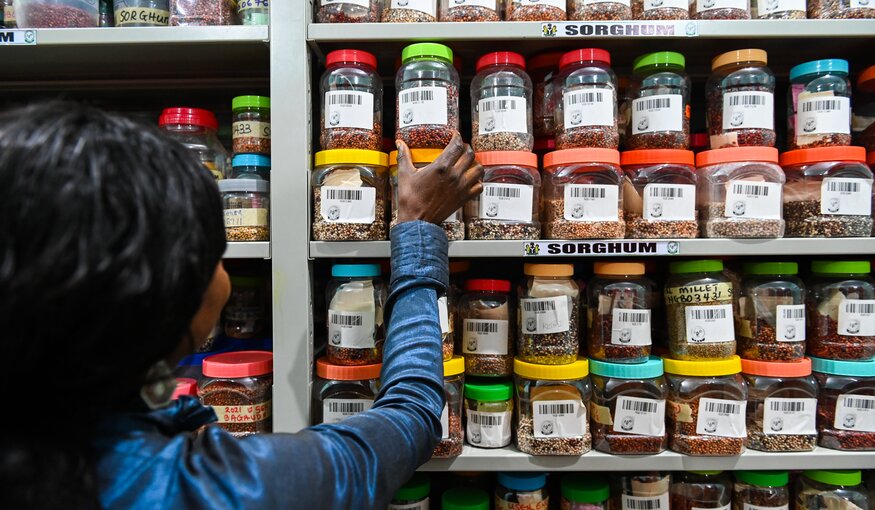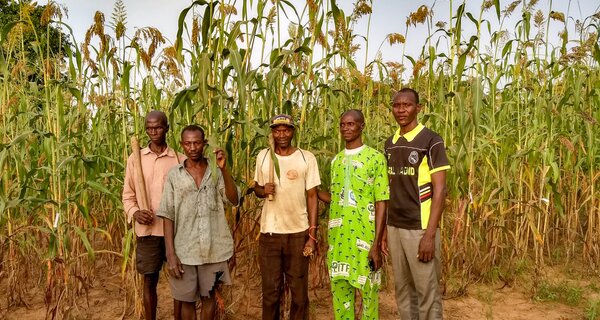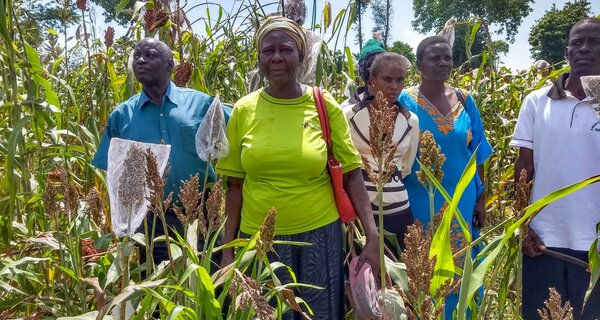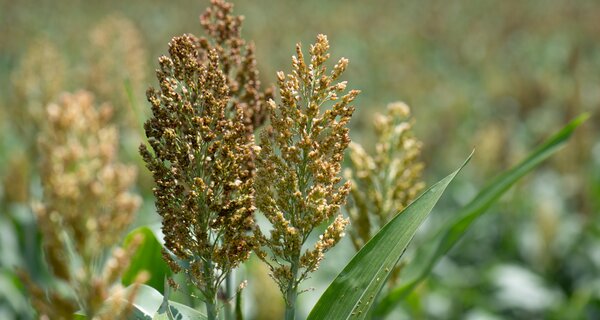Building a Toolbox of Sorghum Diversity
 Seed conservation at the National Centre for Genetic Resources and Biotechnology (NACGRAB) in Ibadan. (Photo: Neil Palmer for the Crop Trust)
Seed conservation at the National Centre for Genetic Resources and Biotechnology (NACGRAB) in Ibadan. (Photo: Neil Palmer for the Crop Trust)17 February 2023
The wild, weedy relatives of our cultivated crops display all kinds of useful traits their domesticated cousins lack – traits that could make our agriculture more resilient to future challenges.
But it takes a lot of time and resources for crop breeders to explore the diversity of wild relatives of our cultivated crops, identify and pull out the good traits, and use them in long-term breeding projects.
With the support of the Crop Wild Relatives Project, breeders at the University of Queensland in Australia have produced a collection of new plants that will help sorghum farmers around the world grow better crops despite changes in the climate.
We spoke with Alan Cruickshank, a crop breeder at Queensland Department of Agriculture and Fisheries (DAF) and one of the project leaders, to learn more about the painstaking but rewarding process of using wild relatives to breed new sorghum plants that will be useful to researchers and plant breeders the world over for decades to come.
What’s so special about sorghum?
Cruickshank: For many people in Africa, and in South Asia too, sorghum is essential for nutrition. It’s part of a cropping system that provides subsistence in very harsh environments where water is often limited, and climate change is already causing more erratic rainfall and more frequent heatwaves. Although sorghum is relatively hardy, it is still vulnerable to changes in its environment, just like any other crop.
We wanted to develop new sorghum plants that had some of the survival traits that the wild cousins had developed. Breeders around the world could then use these new seeds to create specific local varieties that could survive under tough environmental conditions.
What do wild relatives contribute in particular?
We think that all cultivated sorghums descended from just two ancient domestication events. This means that domesticated sorghums may not have many of the traits which wild sorghum populations still have.
The wild relatives that we used in this project come from, and are adapted to, different environments across Africa. So, these wild relatives should carry traits that enable them to thrive in challenging conditions. They might also have traits that are more generally useful, like disease resistance.
What do wild relatives contribute in particular?
We think that all cultivated sorghums descended from just two ancient domestication events. This means that domesticated sorghums may not have many of the traits which wild sorghum populations still have.
The wild relatives that we used in this project come from, and are adapted to, different environments across Africa. So, these wild relatives should carry traits that enable them to thrive in challenging conditions. They might also have traits that are more generally useful, like disease resistance.
Can you tell us a little bit more about your process?
In this project, we started with nine wild relatives of sorghum and two existing, elite sorghum varieties. We first crossed each of the two domesticated parents – the adapted elite parents – with each of the nine crop wild relatives – the donor parents. That gave us 18 sets of progeny, with many looking nothing like the elite parents. So, we did what’s known as a backcross, which is crossing the progeny with the adapted parents. In this way, we created a population that is a bit more similar to the elite varieties, but has all sorts of important additional traits.
In the end, we selected 1,224 different types of sorghum, all with distinct traits. These all have considerable variation in maturity, height, head shape, grain size and many other morphological traits. Like many of our crops, sorghum is sensitive to the ratio of daylight and night. So, we excluded types which were quite sensitive to day length, which would have limited them to specific geographic regions.
We still don’t have to hand all the possible variations in wild sorghum, but we ended up with a range of plants that incorporate many of the genes from wild sorghums into the background of its domesticated counterparts.
What is in store for these new sorghum plants?
Most of these seeds are now accessible through the Australian Grains Genebank and eventually will be shared with some regional collections as well. The breeding data is available on Germinate. Any researcher can look at what we call this panel of sorghum lines and do a study on whatever trait interests them. That’s the beauty of it.
We sent 165 lines to Mali for evaluation by farmers. The seeds were duplicated in Mali and then sent to Kenya for a similar evaluation.
Our partners at the Ethiopian Biodiversity Institute (EBI) are now looking at height and days to flower because the crosses may behave differently at the three different sites in Ethiopia where they work. The trial sites differ in altitude, so they will have the same daylength but different temperatures. In these trials, they will also be looking for pest and disease resistance. If the plants show signs of grain mold, for example, our partners will see how the plants behave. If something else comes along and attacks the crop, they will see how the plants perform. They can then use data from our DNA sequencing and say “OK, what have we got here in terms of genes that might help with this particular stress?”
Did you achieve the outcomes you hoped to?
We haven’t provided researchers and breeders with a magic bullet, there’s no such thing, but we have provided another tool in their toolbox that they can use to confront whatever new challenges climate change brings. These new sorghum seeds and the associated genetic and molecular information aren’t the end of the road. But many more breeders are going to be able to say, “Hey, there is something here that might help us with this new challenge we’re facing here.”
We have essentially saved everybody else the trouble of going back to these wild relatives. That’s at least six years of work that other breeders won’t have to do now.
This is a special project for us. It is making available new sorghum diversity—not just to our own breeding program, but to the world community of sorghum scientists, particularly breeders. That was a big motivation for us.
It was great to be able to focus on wild relatives. That’s not something our mainstream breeding program would allow us to do, because of limited funding. But it’s where the most interesting and potentially valuable diversity is.
###
Categories: Crop Wild Relatives, Sorghum
About the Crop Wild Relatives Project
The Crop Wild Relatives Project was developed to collect important species of crop wild relatives, ensure their long-term conservation and facilitate their use in breeding new, improved crops. This 11-year project was launched in 2011 with USD 50 million in funding from the Government of Norway. Managed by the Crop Trust with the Royal Botanic Gardens, Kew, the project was implemented in partnership with national and international genebanks and plant breeding programs around the world. The work is continuing under the “Biodiversity for Opportunities, Livelihoods and Development” (BOLD) Project, which is also funded by the Government of Norway.




